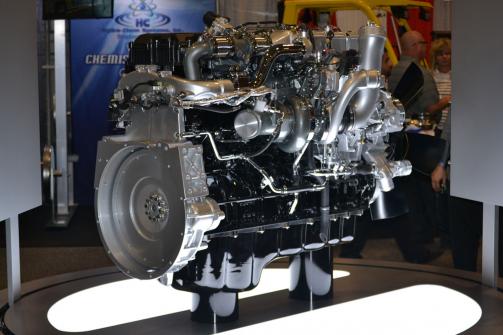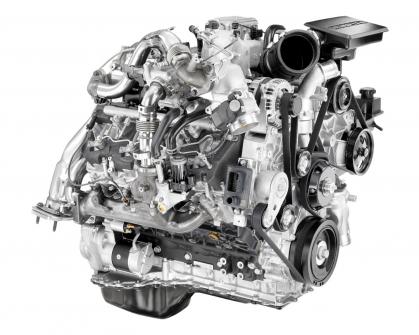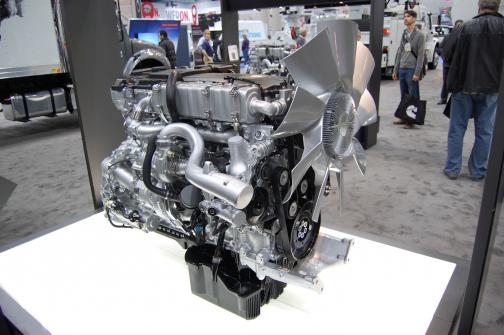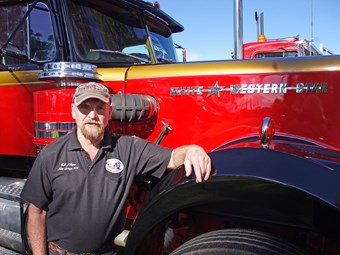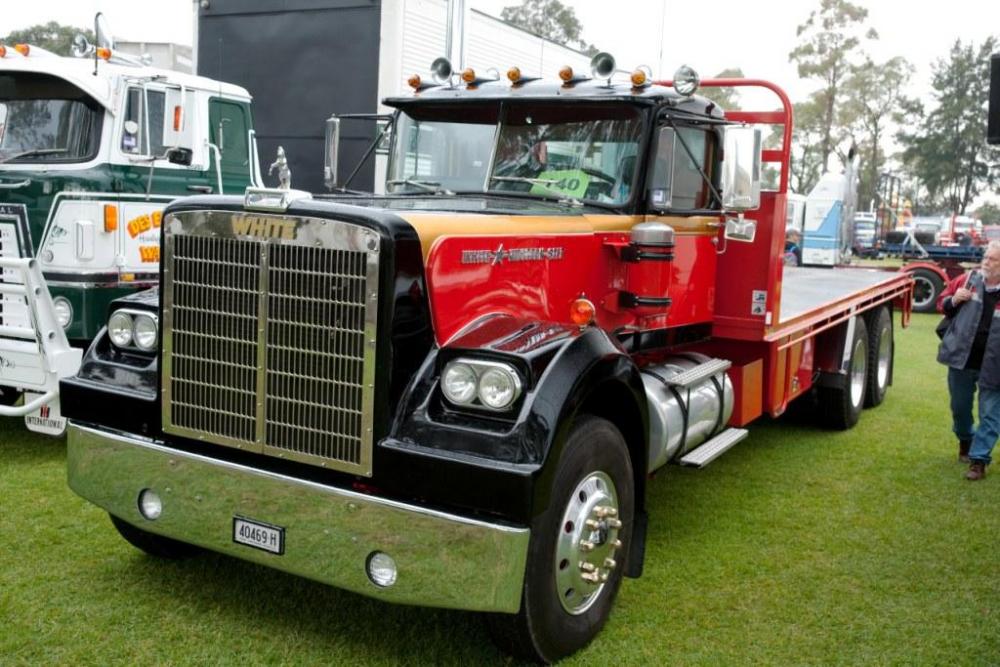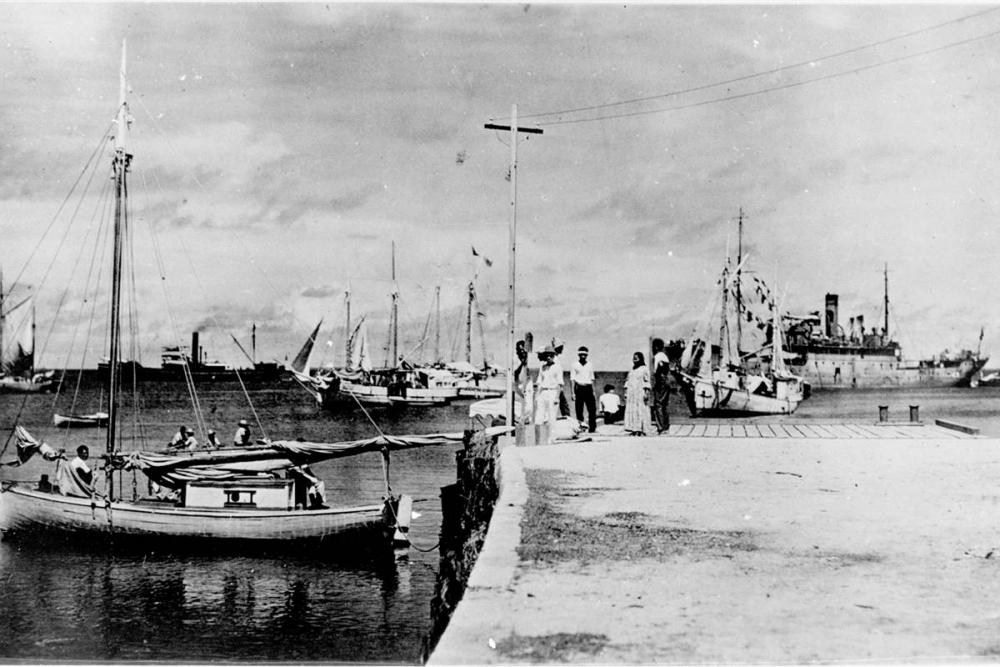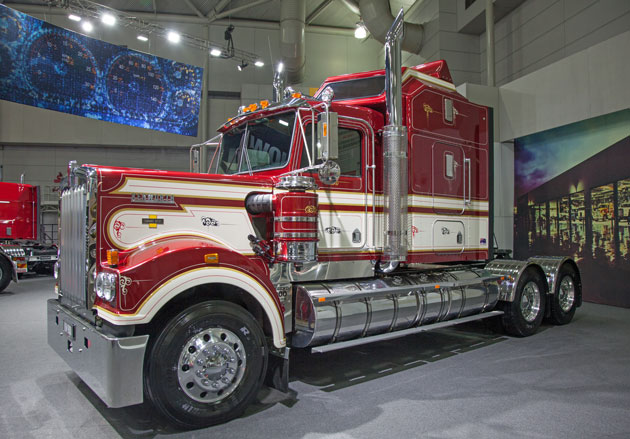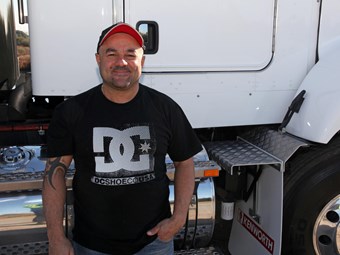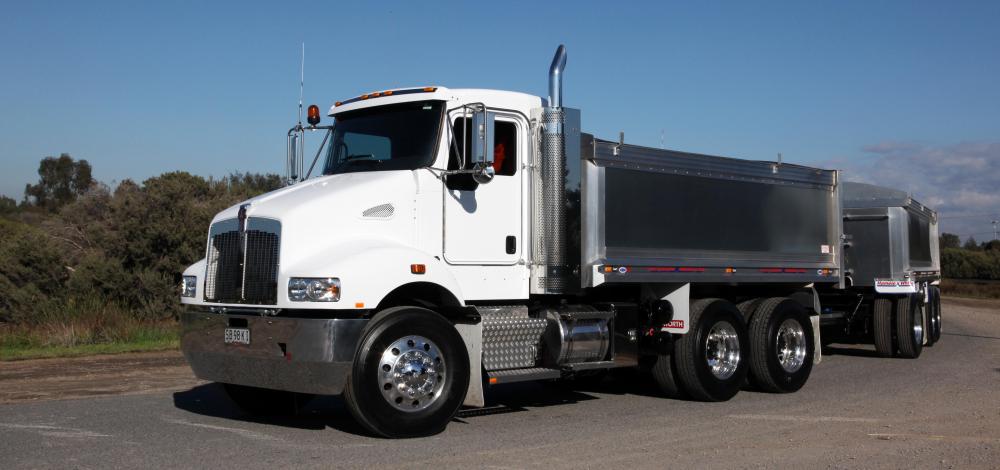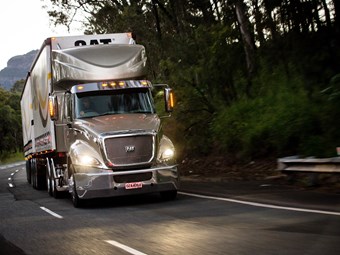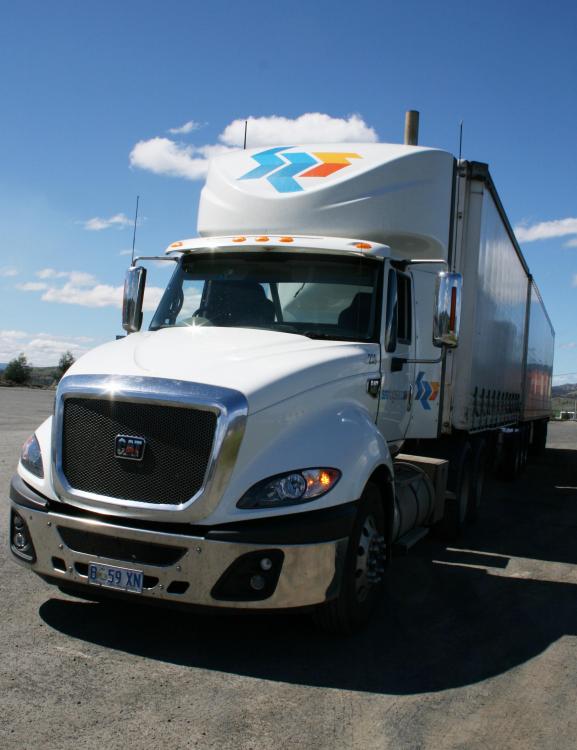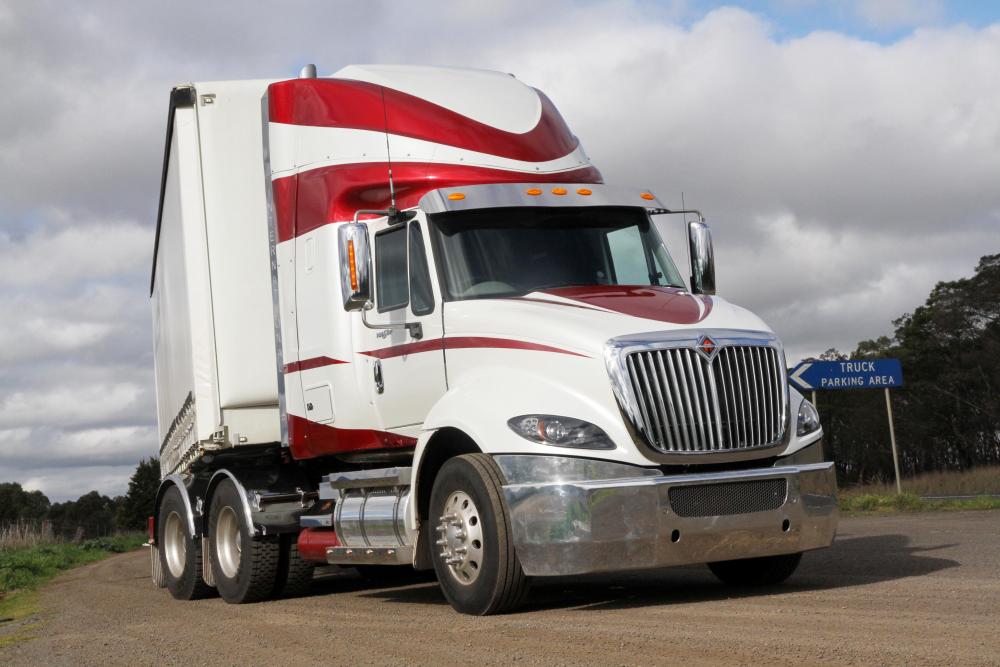
kscarbel2
Moderator-
Posts
18,928 -
Joined
-
Days Won
114
Content Type
Profiles
Forums
Gallery
Events
Blogs
BMT Wiki
Collections
Store
Everything posted by kscarbel2
-
International A26 A brand new entrant to the diesel truck engine playing field is the International A26, which is built on a MAN D26 engine crankcase supplied to Navistar by Europe’s Volkswagen Truck & Bus unit. This is the first product to develop from an alliance between the two OEMs that began in late 2016. The A26 produces up to 475 hp. and 1,750 lbs.-ft. of torque from a design that’s 600 to 700 lbs. lighter than a traditional 15-liter big bore engine, Navistar noted. Using a titanium compressor wheel with a simplified single-stage design, the A26 features a variable geometry turbocharger that reduces complexity and enhances reliability. Larger piston pins, connecting rods and bushings help optimize load distribution for enhanced durability; smaller piston cooling jets increase oil pressure to improve lubrication, increasing oil change service intervals up to 70,000 miles. Weighing in at 2,299 lbs., the A26 is 55 lbs. lighter than the engine it replaces and helps shed another 200 lbs. of weight in vehicle-mounted components. Its compacted graphite iron crankcase has greater strength and fatigue resistance than traditional gray iron. Composite valve covers and shot-peened aluminum flywheel housing help deliver impressive weight savings over traditional solutions, Navistar noted. The A26 also sports what the OEM calls a simplified air management system, featuring a new variable geometry turbocharger. Fuel injection pressure is maximized by the engine’s 36,300 psi high pressure common rail fuel system. New cylinder head coolant passages are 50% less restrictive to reduce parasitic loss to the water pump—that helps the A26 reduce fuel consumption and emissions. The A26’s sculpted crankcase, which is isolated with the oil pan through a specially designed rubber gasket, absorbs vibration and reduces harshness for a quieter in-cab experience. In addition, the engine’s six-blade fan, specially designed gear teeth, and sophisticated calibration and programming are built to reduce engine noise. .
-
GM Duramax 6.6-liter diesel V8 The newly redesigned duramax 6.6-liter V8 turbocharged diesel, built via a partnership between General Motors and Isuzu, shares only the bore and stroke dimensions from its previous iteration. It now cranks out 445 hp. and a net 910 lbs.-ft. worth of torque, which is 19% more torque compared to the previous Duramax incarnation. The new Duramax is an optional engine selection for Chevrolet and GMC heavy-duty pickups with many new internal component changes built in, i.e., a stronger cylinder block and cylinder heads, a stronger rotating and reciprocating assembly, increased oil- and coolant-flow capacity, a new exhaust gas recirculation system with single cooler and integrated bypass, an all-new solenoid fuel system, all-new electronic controls, a new electrically actuated/electronically controlled turbocharging system, new rocker cover/fuel system acoustical treatments, and B20 biodiesel fuel compatibility. A patent-pending vehicle air intake system helps drive cool, dry air into the engine for sustained performance and cooler engine temperatures while operating in difficult conditions. A new two-piece oil pan also helps make the new Duramax operate some 38% quieter at idle compared to the previous model. The aluminum section of the laminated steel oil pan not only provides strength-enhancing rigidity for the engine, but dampens noise and vibration. GM said its new venturi jet drain oil separator is the first of its type in the engine segment and helps ensure better oil control in sustained full-load operation. The sealed system collects the fine mist of oil entrained in the blow-by gas and uses a small portion of the boosted air generated by the turbocharger to pump the collected oil back to the engine oil sump for reuse by the engine. .
-
Detroit DD8 The Detroit DD8 medium-duty engine is completely new for 2018 and officially starts production in February of next year. In November 2015, parent company Daimler Trucks North America (DTNA) made an investment of $375 million to bring manufacturing of the proprietary DD5 and DD8 medium-duty engines to its facility in Redford, MI. Aimed at the vocational truck market, the DD8 is a 7.7-liter in-line, 6-cyl. medium-duty platform that offers between 260 and 350 hp. and a torque range of 660 to 1,050 lbs.–ft. It will also be offered with both engine and transmission power-take-off options. The DD8 will initially be available in the Freightliner M2106, 108SD and 114SD models. The DD8 will eventually be made available for Freightliner Customer Chassis Corp. vehicles by the fourth quarter of 2018 and will also be offered as a rear engine only option for school bus models sold via DTNA’s Thomas Built Buses subsidiary by the end of 2018 as well. Vehicles equipped with the DD8 will feature the Detroit Connect Virtual Technician remote diagnostic service to help provide access to in-depth vehicle data to make repairs as accurately and quickly as possible. .
-
Professional int’l level truck show coming to U.S.
kscarbel2 replied to kscarbel2's topic in Trucking News
NACV Show names official hotels Today’s Trucking / July 7, 2017 ATLANTA, GA – Official hotels and room rates have been established for those attending the inaugural North American Commercial Vehicle Show (NACV Show) this September. “Excitement for the inaugural NACV Show is building, and we expect a North American audience of fleet decision makers, industry leaders and influencers will attend this important industry event in September,” said Larry Turner, president and Chief Executive Officer of Hannover Fairs USA and co-organizer of the NACV Show. The NACV Show housing website offers available rooms in the Atlanta area starting at US $119 per night. “Now is the time to register to attend the show and to secure accommodations as room blocks are filling up,” added Turner. The NACV Show is open to the press only on Sunday, September 24 and is open to exhibitors and invited guests on September 25. General admission for fleet representatives and non-exhibiting suppliers is September 26-28. To register to attend the North American Commercial Vehicle Show 2017, go to attendee registration. To view the entire trade show floor, visit NACV Show 2017 floorplan. A current list of exhibiters is located at NACV Show 2017 exhibitors. -
U.S. Truck Orders Fall for the Quarter, Up Big from Last Year Heavy Duty Trucking / July 7, 2017 Truck orders in the heavy- and medium-duty segments fell in the second quarter of 2017, but are still much higher than they were a year ago. Class 5-8 orders for the second quarter hit 43,000 units, up more than 37% year-over-year but down 6.5% from the unexpectedly positive first quarter of the year. The numbers are still preliminary for June; final data will be published in mid-July. Class 8 orders alone jumped to 18,100 units in June, increasing 1,200 units from May. This represents an increase of 39% compared to June of last year. “Because of a deep seasonal trend that runs through Class 8 orders, seasonal adjustment provides a significant boost to June’s orders,” said one analyst. ”When adjusted, the June volume rises to 20,200 units.” Class 5-7 medium-duty truck orders moderated from May, slipping 1,500 units to 20,200 units in June. This was up 34% compared to last June’s order intake. “Seasonal adjustment boosts June’s MD order volume to 22,700 units, roughly in line with May’s seasonally adjusted tally (22.8k),” he said. “In the second quarter, Classes 5-7 orders were booked at a 255k SAAR, down from a 274k SAAR in Q1.”
-
Sean Kilcarr, Fleet Owner / July 7, 2017 Almost all of the major diesel engine makers are either rolling out new platforms or making changes to current products across a range of displacements for this year as well as for 2018. Makeovers include weight reductions and combustion system redesigns, among other improvements, largely to help them meet federal greenhouse gas (GHG) emissions targets. Those targets are ostensibly about reducing carbon dioxide emissions, yet in terms of real-world impact, they translate into mandates for lower fuel consumption. Thus, diesel truck engines not only must generate the same if not more horsepower and torque as before, they must also burn less fuel. That’s no easy feat for engines being tasked with pushing fully loaded pickup trucks through the mud or hauling 80,000 lbs. of freight at highway speeds. And not all of the new engines in the diesel segment are fully revealed yet, as Ford Motor plans to introduce a new 3.0-liter Power Stroke diesel engine by the end of this year. The engine will be paired with its 10-speed automatic transmission. This platform is earmarked to be the first-ever diesel engine offering for its F-150 pickup family. This section is by no means fully comprehensive. More changes are in store for the diesel engine landscape as a second round of GHG mandates remains poised to impact trucks and their related components for the 2021 through 2027 model years. These are interesting times for diesel engine designers. To see all of this year's featured engines, visit our special gallery below: New Engines photo gallery
-
Sean Kilcarr, Fleet Owner / July 7, 2017 When it comes to detailing what’s truly “new” regarding this year’s crop of new models, it’s not all about the physical components that make up tractors and trucks anymore. Sure, we can talk about engine offerings, aerodynamic shaping, brake system types, and much more. Yet often, many of the new features on a commercial vehicle touted as a new model today are now also centering on items such as built-in remote diagnostic capabilities or new telematics packages that help foster deeper collaboration between fleets and other customers, dealers and specific OEMs. Some of the new upgrades involve the addition of alternative fuel packages that allow certain trucks to be reconfigured to run on compressed natural gas (CNG), propane, electricity, or some form of energy that isn’t purely diesel or gasoline fuel. General Motors is one OEM making a big push in that direction for this year as well as 2018 and beyond. Often, too, the “new model” designation encompasses enhancements made to a particular configuration within certain truck brands—enhancements that focus on vocational applications, or ones related to fuel economy. Then there are the custom configurations OEMs are introducing across the truck spectrum, especially in the light vehicle space, to try to capture more business from consumers and commercial clients alike by offering beefier off-road specs or work truck packages that better tune vehicles for specific kinds of operating environments. Ram Trucks has been very involved in this type of activity of late. So have other OEMs—it’s all part of creating more versatile work tools for the commercial fleet customer in the modern era, explained John Schwegman, U.S. director of commercial product and medium duty for the General Motors fleet division. In an interview with Fleet Owner, he stressed that although the demand for greater fuel economy “has always been important and will stay that way,” especially for light- and medium-duty units, the desire now is for more options and overall capability when it comes to vocational-focused platforms. “These fleets don’t want a lot of frills, but they do want functionality,” he explained. “They don’t want leather interiors or chrome, but they do want safety features such as collision mitigation and automatic emergency braking systems. There is a definite trend towards a willingness to pay for them.” That’s one reason that more mid-level and base-level trim packages will incorporate safety technology now and in the future. “They’ve become very popular [systems] across the work truck buyer spectrum; we’ve heard that loud and clear,” Schwegman noted. That holds true on the heavy-duty end of the truck spectrum as well. For example, Peterbilt Motors is making the Bendix Wingman Advanced collision mitigation technology package a standard feature on its Model 579 highway tractor, while Navistar is going to make Bendix-brand air disc brakes standard equipment on each axle of its brand-new LT Series highway tractor. While the goal of such new model features is to improve safety for truck drivers and other motorists surrounding them on the highway, there are potentially big cost benefits for trucking companies, too. In fact, one fleet that tested collision mitigation technology found it reduced rear-end crashes by about 70% while also cutting by 70% the severity of the remaining 30% of crashes. To see all of this year's featured trucks, visit our special galleries below: New Models photo gallery part 1 New Models photo gallery part 2
-
New Mack sneak peek
kscarbel2 replied to Jamaican Bulldog's topic in Modern Mack Truck General Discussion
The Mack brand chassis has been the North American market Volvo chassis for many years now. Volvo of course designs their chassis. The frame components are produced by Mexico's Metalsa. -
Sweden's Volvo sells stake in engine maker Deutz
kscarbel2 replied to kscarbel2's topic in Trucking News
Absolutely Bob, Volvo has been Deutz's largest customer in the construction segment. Volvo and Deutz got together in 98. They jointly designed a 4-valve 7-litre engine, the first Deutz engine seriously created for vehicular use rather than general industrial applications. It was called the D7 and was fitted into many Volvo city buses. Then Volvo bought Nissan Diesel (UD) and discovered they were on the verge of launching an all-new modern 7-litre engine. Volvo then stopped using Deutz engines in vehicles and switched to the UD engine. They did continue buying Deutz engines for Volvo Construction Equipment (VCE). But I think that's all going to change now, despite Volvo saying it will go on. This is the beginning of the end of Deutz. It's entire portfolio is older engine technology, its customer base has declined and limited financing. -
Bob, the chassis and drivetrain of this Volvo-designed North American market Mack brand truck are............Volvo, thru and thru. They took the cheapest way out they could to update their Pinnacle highway model and address Mack Distributor Council complaints. Remember, Volvo is financially challenged now and Mack is not a money maker. It's funny in a way that in the year 2018, Volvo is still using a cab architecture designed by the former Allentown-based Mack Trucks in 1984.
-
Mack brand Press Release / July 6, 2017 https://www.macktrucks.com/newmack/landing/
-
Greg Bush, Owner-Driver / July 6, 2017 Western Sydney-based Lawrie Lowe has always had an interest in classic American trucks, his pride and joy being a 1973 White Western Star. Lawrie Lowe’s regular occupation is repairing earthmoving gear. However, his passion lies in classic trucks and restoring them to their former glory. Lawrie’s 1973 White Western Star is a familiar site at classic truck shows, especially the Sydney Classic and Antique Truck Show, which is held annually each May at Penrith’s Museum of Fire. Its logo, stunning paintwork and the fact that it’s a left-hand drive truck regularly attracts curious onlookers. Lawrie has owned the truck since Christmas 2009, and as well as spending countless hours doing it up, he’s also well versed on the truck’s background. "In 1967 White Motor Company set out to build a truck aimed at the west coast US market," Lawrie explains. "The west coast trucks were traditionally long bonnet, long wheelbase, aluminium chassis – which this truck is, because they were hauling the greater distances. "East coast US trucks were a different truck to this, a shorter bonnet, short wheelbase, cities being closer together so shorter distance hauling.," he says. "Our main roads specs at the time were more closely based on what the east coast American trucks were, so that was where the western bit came into it." Lawrie has researched Western Star’s history, including the turn of events that led Volvo Trucks buying the insolvent White Motor Company in 1981. "But the plant in Kelowna, British Columbia, Canada that built the Western Stars wasn’t part of the deal." Lawrie says the truck he now owns spent its working life around California carting mainly prefab house frames and roof trusses. He believes the owner retired it around 1996. "The guy I bought it off and his mate stumbled across it in the ’States in a wrecking yard. "One of them bought it and brought it over and it sat for about five years in a truck repair yard at WetherillPark, half pulled apart. "The other guy got it, put it together and moved it over to Llandilo, but after a time he got sick of moving it in and out of the shed to work on other stuff, so he parked it outside and that’s when I first saw it." Lawrie thought the truck had only just arrived in Australia, so he thought there was no chance of it being up for sale. "About five years later, after a few beers, and having decided they weren’t going to do anything with it, I called in to see if it was for sale. Five minutes later I bought it." Lawrie thought it would be a simple case of taking it home, getting into it with a big Gerni and blowing off all the rust, hitting it with rust converter and try and bog up the holes and paint it flat black. The truck’s seller, however, begged to differ. "You can’t do that to that truck, you’ve got to get rid of that rust, you’ve got fix it properly," he told Lawrie. That was Christmas 2009, and Lawrie worked on it every weekend and each night after work. "I was going through a marriage breakup at the time, and it was the only thing that kept me a little bit sane to take my mind off what I was going through," he says. Lawrie was able to get the truck registered just in time for the National Road Transport Reunion at Alice Springs in 2010. It was the truck’s maiden voyage under his ownership. "Because it had been sitting for so long, the cab was very badly rotted out and I spent an awful lot of money," he says. "The guy that I bought it off builds hot rods, and he did all the rust repairs and the paint on the cab and bonnet for me." Lawrie has since driven the White Western Star for over 20,000 mostly trouble-free kilometres. "I did a water pump one day 10 minutes after leaving home," he continues. "I had a spare water pump with me because I’d been advised before I went to Alice Springs that I should get one because they’re getting a bit hard to get a hold of for these early small-cam engines." Lawrie has resisted the temptation to convert the truck to right-hand drive. He wants it to remain an example of the typical American truck. "I could do it quite easily," he says. "The good thing about these particular cabs is the dashboard’s held in with three bolts on one side, two over on the other side, and you’ve a couple where the steering column mounts to the firewall. "I could just pull that dash straight out of there, and bolt in a dash out of the 4000 or 9000, or the later Diamond Reos or Autocars or anything." .
-
IVECO's countdown to the 2017 Silk Way Rally – the Russia to China rally raid – has begun IVECO Trucks Press Release / July 6, 2017 The PETRONAS De Rooy IVECO Team will participate in the Silk Way Rally for the first time. The race crosses Russia, Kazakhstan and China, totalling almost 10,000 km split into 14 stages. The Silk Way Rally 2017 will get underway with a ceremonial start in Moscow's Red Square on July 7, ending 15 days later in the city of Xi’an in China. Along the route competitors will complete 14 stages and cross three countries – Russia, Kazakhstan and China – on a route totalling 9,608 km. IVECO has joined forces once again with the PETRONAS De Rooy IVECO Team: three IVECO trucks – two Powerstars and one Trakker – will compete, backed up by their support team. After technical and administrative checks, the rally gets underway with the first three stages in the Republics that span the Volga and the Bashkortostan regions of Russia. The subsequent four days will be particularly intensive, against the backdrop of the extraordinary landscape of Kazakhstan's steppes. The first Chinese stage will be followed by a rest day – July 16 in Urumqi – that will open the GobiDesert leg. This will mark the start of the toughest part of the competition: seven stages that will see participants navigate the GobiDesert's dunes and treacherous tracks before finally reaching the legendary city of Xi’an. Pierre Lahutte, IVECO Brand President, said: "The PETRONAS De Rooy IVECO Team's schedule is particularly intense and we are proud to be able to support our drivers once again in this new adventure that will take us to Asia. The strength and versatility of the Trakker and the unique features of the Powerstar, coupled with the abilities of our crews, will enable us to take on and master even the most challenging routes.” The PETRONAS De Rooy IVECO Team at the 2017 Silk Way Rally Gerard De Rooy, Team leader, on board his new Powerstar, will be flanked by the highly experienced co- pilot Moi Torrallardona. The experienced mechanic Darek Rodewald will travel with them to provide technical support during the competition. With the race nearing, De Rooy stated: "The Silk Way Rally will be a very important test for us. We will participate with three trucks, driven by me, Ton van Genugten and Artur Ardavichus. I can't wait to embark on this new adventure.” The Kazakh Artur Ardavichus, who is a new entry to the team, will have his debut on board the second IVECO Powerstar with Belgian co-pilot Serge Bruynkens and Dutch mechanic Michel Huisman, who are both coming back to the De Rooy Team. “I so much wanted to become part of a highly professional team like this, after witnessing both its organisational capabilities and the excellent IVECO trucks as a competitor over the past few years. I want to make an excellent impression in a race that takes place ‘in my backyard’.” Joining the two Powerstars will be an IVECO Trakker driven by Ton van Genugten, supported by the new - but experienced - Spanish co-pilot Marco Alcayna Ferran and the mechanic Bernard Der Kinderen. “This is my debut at the Silk Way Rally and my mission is to follow Gerard like a shadow and support his new Powerstar. It will be great training for the next Dakar." A long-standing IVECO partner, PETRONAS Lubricants International, will guarantee its support during the 2017 Silk Way Rally. PETRONAS Lubricants International, as title sponsor and technical partner for the PETRONAS De Rooy IVECO Team, will provide lubricants and functional fluids for rally and support vehicles. The team will use PETRONAS Urania premium engine oil, formulated with the advanced additive technology, specifically designed for total engine protection, enhanced efficiency and performance. The vehicles in the race The IVECO Trakker is a vehicle designed to excel in even the most extreme off-road missions for wheeled vehicles. With models which range from 18 to 72 tonnes, the Trakker represents the perfect combination of strength and reliability, and boasts the enhanced comfort of the new generation Stralis cabs – with a choice between Hi-Land (day cab) or Hi-Track (sleeper cab) options. The Trakker range, available in left or right-hand drive, offers extensive scope for customisation for a host of specific missions, courtesy of the IVECO Cursor 9 and Cursor 13 engines. Both cab versions are available in 4x2, 4x4, 6x4, 6x6 and 8x8 configurations, with engine powers ranging from 310 to 500hp. Whether used for working in extreme off- road conditions or for mainly on-road missions with occasional off-road operations, the Trakker can be equipped to optimise payload and fuel consumption. Follow all developments on www.iveco.com/SilkWay IVECO will keep fans updated during the rally on www.iveco.com/SilkWay , with daily updates from Asia published in English, Russian and Chinese. Social media channels and the IVECO press site will also be updated daily with news, reports, videos and photos. .
-
Sweden's Volvo sells stake in engine maker Deutz
kscarbel2 replied to kscarbel2's topic in Trucking News
Volvo Group sells its shares in Deutz Volvo Group Press Release / July 6, 2017 Volvo Group has today sold its complete holding in the German listed engine manufacturer Deutz AG. Divestment proceeds amount to SEK 1,897 M, corresponding to SEK 62.73 per share (EUR 6.50). The sale will result in a capital gain of approximately SEK 350 M that will impact operating income in the third quarter of 2017. Volvo Group has sold 30,246,582 shares, corresponding to 25% of total shares in Deutz. The sale will have a positive impact on Group cash flow and the net financial position in the Industrial Operations in an amount of SEK 1,897 M. The capital gain will be reported in the segment “Group functions and Other”. -
Reuters / July 7, 2017 Sweden's AB Volvo said on Friday it had sold its 25 percent stake in German diesel engine maker Deutz AG as the truck maker continued to trim assets outside its core business. Volvo said in a statement that proceeds from the sale, which was carried out through a bookbuilding process, amounted to 1.9 billion Swedish crowns ($225 million) and would generate a capital gain of about 350 million crowns. As part of a push to boost profits at the sprawling group, Volvo has been shedding peripheral businesses in recent years. Among them, it sold its external IT operations and a portfolio of properties last year and expects to sell its largely military Governmental Sales unit later this year. Volvo said the capital gain from the divestment of shares in Deutz would be booked in the third quarter. The truck maker reports second-quarter results on July 19.
-
Fleet Owner / July 6, 2017 While medium-duty orders slipped overall in June, volume remains strong year-over-year. Orders for new Class 8 trucks rebounded in June after a falloff in May, and though they are lower quarter-over-quarter, year-over-year Class 8 order comparisons are “positive by a wide margin,” noted one industry analyst. “While orders are weak relative to year-to-date activity, June’s orders were up 39% compared to last year,” he said. Class 8 orders rebounded to 18,100 units in June, and because of a “deep seasonal trend” that runs through Class 8 orders, seasonal adjustment provides a “significant boost” to June’s volume. “When adjusted, the June volume rises to 20,200 units,” he said. FTR Transportation Intelligence reported similar numbers and trends as it pegged preliminary Class 8 net orders for June at 17,600 units; a month-over-month improvement of 7% and 38% better than June of 2016. “The Class 8 market continues to perform at a steady pace and is consistent with summer’s seasonal trends [with] total orders for the past twelve months totaling 216,000 units,” noted Don Ake, FTR’s vice president of commercial vehicles, in a statement. “June orders confirm that the market just took a brief respite in May after several stronger than expected months,” he added. “The orders are right where we expect them to be and on track with our forecast. The fact that orders are up 38% over last year proves the market is much improved this year.” Ake pointed out that the uptick in orders in June also shows that the Class 8 new truck market “is steady, stable and primed for a strong year in 2018.” In terms of medium-duty trucks, ACT’s Vieth said North American orders for Class 5-7 units dipped to 20,200 units in June, down 1,500 units from May. Yet he stressed that “seasonal adjustment” boosts June’s medium-duty order volume up to 22,700 units, roughly in-line with May’s seasonally adjusted tally of 22,800 units. Overall, North American Class 5-7 orders were up 34% compared to June of 2016, he added.
-
FCA resumes Ram 1500 diesel output Automotive News / July 6, 2017 Automaker is still awaiting EPA certification to sell pickup DETROIT -- Fiat Chrysler has begun assembling diesel-powered Ram 1500 pickups again for the first time in months, workers at the company's Warren Truck Assembly plant in Michigan say, though the automaker and environmental regulators have yet to resolve a dispute over alleged excess diesel emissions and undeclared emissions software. Workers at the suburban Detroit factory told Automotive News that the plant is producing less than two dozen 2017 Ram 1500s per shift powered by the 3.0-liter turbodiesel V-6, previously marketed as EcoDiesel. It is unknown whether Ram will resume use of the EcoDiesel brand name for the engine after it receives approval to sell the light-duty diesel-powered pickups. Recent mules of the Ram spotted in metro Detroit carry new badging that simply says "Diesel." The plant stopped building EcoDiesel Ram 1500s in the middle of 2016 after the EPA raised questions about undeclared emissions software in 2014-16 EcoDiesel Ram 1500s and Jeep Grand Cherokee SUVs. In January, the EPA hit FCA with an official Notice of Violation over the software, which it said illegally altered vehicle emissions under certain circumstances. And in May, the Department of Justice's Environmental and Natural Resources Division filed a civil suit against FCA over undeclared diesel emissions software. FCA has said it is working with the EPA and California Air Resources Board "to clarify issues related to the Company's emissions control technology." On May 19, the company formally sought certifications from regulators to put its light-duty diesels back on sale. The Ram 1500 diesels being produced will likely be used to refill dealer stocks when FCA is cleared by regulators to sell diesel-powered light-duty pickups. A spokesman for FCA declined to comment on the status of diesel-powered Ram 1500 output. However, the company did say in late May that it "has developed updated emissions software calibrations that it believes address the concerns of EPA and CARB, and has now formally filed for diesel vehicle emissions certification with the regulators for its 2017 model year Jeep Grand Cherokee and Ram 1500 diesel vehicles. Subject to the permission of EPA and CARB, FCA US intends to install the same modified emissions software in 2014-2016 MY Jeep Grand Cherokee and Ram 1500 diesel vehicles. FCA US believes this will address the agencies' concerns regarding the emissions software calibrations in those vehicles."
-
Ex-Audi manager faces U.S. charges over VW diesel emissions Bloomberg / July 6, 2017 A former Audi AG manager was charged with fraud by the U.S. for his alleged role in helping Volkswagen AG cheat U.S. emissions standards. Giovanni Pamio, 60, conspired to defraud U.S. regulators and consumers through software designed to cheat emissions tests in thousands of Audi vehicles marketed as "clean diesel," the Justice Department said in a news release Thursday. "Pamio and co-conspirators deliberately failed to disclose the software functions, and they knowingly misrepresented that the vehicles complied with" emissions standards, the government said. Pamio is the eighth person charged in the U.S. case against Volkswagen, which has cost the automaker more than $24 billion in government penalties and owner restitution. Audi is a division of VW. An Italian citizen, Pamio worked for Audi’s diesel-engine development department in Neckarsulm, Germany. After realizing that it was impossible to calibrate a diesel engine to meet emissions standards within the company’s design constraints, Pamio directed Audi employees to implement software functions to cheat the U.S. emissions tests, the Justice Department said. Audi spokesman Toni Melfi declined to comment and said he couldn’t provide contact information for Pamio. Audi, which is the main profit generator at the larger carmaker, has suffered setbacks in its efforts to emerge from the emissions-cheating scandal. German prosecutors raided the company in March in connection with consumer-fraud investigations related to the case. Defeat devices VW admitted in September 2015 that about 11 million diesel cars worldwide were outfitted with so-called defeat devices, embedded algorithms used to game emissions tests. An agreement with regulators requires VW to compensate owners of 3-liter diesel engine vehicles, fix about 58,000 cars and buy back as many as 20,000 Touareg and Audi Q7 SUVs. Pamio, who was identified in a lawsuit as head of Audi's V6 diesel engine development for the U.S., left the company earlier this year. He was described in a 2008 article in Automotive Design & Production as one of the founding fathers of common-rail diesel design, a fuel injection system developed by Fiat that became the industry standard. In October 2006, Pamio was among several VW executives and managers who met with officials of the California Air Resources Board to discuss emissions standards for future light-duty vehicles, according to a lawsuit filed against VW last year by the state of New York. Pamio was involved in a follow-up meeting with CARBÂ on March 21, 2007, where emission control devices that would be installed on the future vehicles were discussed and VW said the emissions control system would work under "normal vehicle operation," according to company documents cited in the New York lawsuit. While making these assurances to CARB, Pamio and more than a dozen other VW executives and managers were secretly developing defeat devices, according to New York's complaint. Oliver Schmidt, who was VW's liaison with U.S. regulators, in February pleaded not guilty to charges of fraud and conspiracy in the case. He is in custody in the U.S. since his arrest in January while on vacation in Florida. James Liang pleaded guilty in September to conspiring to defraud regulators and is cooperating with the investigation. He is free on bond while awaiting sentencing. The others are in Germany, where they are protected from extradition.
-
If true, possibly an agreement was reached by the United States and Japanese governments at the time of surrender that the truth would never be told. The question is why.
-
Associated Press / July 6, 2017 The photo is haunting. Among a number of figures gathered on a dock, the fuzzy image seems to be that of a woman, her back to the camera, gazing at what may be her crippled aircraft loaded on a barge, and perhaps wondering what her future might hold. Is this Amelia Earhart, the world-famous aviator, witnessed after her mysterious disappearance while attempting the first round-the-world flight 80 years ago this month? That is the theory put forth in "Amelia Earhart: The Lost Evidence," a two-hour documentary airing Sunday at 9 p.m. EDT on the History channel. It uncovers records, including this newly revealed photograph that shows what may be a healthy Earhart along with her navigator Fred Noonan, after they were last heard from. The film also argues that after the pair crash-landed in the Japanese-held Marshall Islands, they were picked up by the Japanese military and that Earhart, perhaps presumed to be a U.S. spy, was held prisoner. And there's more: The United States government knew of her whereabouts and did nothing to rescue her, according to the film. The disappearance of Earhart and Noonan on July 2, 1937, in the Western Pacific Ocean has gained legendary status among the age's unsolved mysteries. By then she had already logged numerous aviation feats, including that of being the first woman to fly solo across the Atlantic Ocean in 1932. She reigned as an international hero. And yet the U.S. government closed the book on its investigation just two weeks after her disappearance. Its vaguely worded findings were inconclusive. Was there a cover-up? The film proposes there was. The documentary is hosted by former FBI Executive Assistant Director Shawn Henry, whose fascination with the case is equaled by former U.S. Treasury Agent Les Kinney, who discovered the photo hidden and mislabeled in the U.S. National Archives. In the documentary, that photo is subjected to facial-recognition and other forensic testing. It is judged authentic, and likely that of Earhart and Noonan. The film also displays plane parts found in an uninhabited island of the Marshall Islands by Earhart investigator Dick Spink that are consistent with the aircraft that Earhart was flying on her round-the-world attempt. And it hears from the last living eyewitness who claims to have seen Earhart and Noonan after their crash. The documentary tells of "a world-famous aviator who got caught up in an international dispute, was abandoned by her own government, and made the ultimate sacrifice," Henry sums up. "She may very well be the first casualty of World War II." .
-
Legend 900 Kenworth’s most successful heritage model to date Prime Mover Magazine / July 5, 2017 Kenworth’s special edition ‘Legend 900’ model, which premiered at the Brisbane Truck Show in May, has been sold more than 250 times during a one-day sale event last week. Combining modern technology with limited edition features and a uniquely Kenworth heritage feel, the Legend 900 is the second historic tribute model after the Legend 950, which was released in 2015. It is inspired by the T900 Kenworth introduced in 1991, which in turn referenced the brand’s legendary W-model. “Built to revive the character of the American-style long bonneted truck, the T900 showcased its own elegance and class and all that was attractive in the much-sought-after W-model,” Kenworth reminisced when unveiling the replica version. Building on that ‘dual’ legacy, the Legend 900 turned out to be a veritable crowd magnet in Brisbane. Boasting the traditional split windscreen, side-mounted exhausts with a wraparound cover and the original flat dash layout – as well as all the traditional Kenworth, Cummins and Eaton Fuller badges – Kenworth said the ‘pull’ of the Legend 900 directly translated into sales a month later. While the Legend 950 model was limited to 75 units, however, the Legend 900 went to market with a different strategy – it was sold for one day only on Monday, 26 June, with no limit to overall volume. According to Kenworth, sales came in in a steady stream, with some customers requesting specific production numbers to suit special occasions in their companies’ history. The result is a one-off 250+ production run, making the Legend 900 the company’s most successful replica model to date. “The common thread carried through the Legend Series models is the compelling combination of the latest technology for safer, cleaner and more productive operation, with iconic design features that help many enduring memories live on,” explained Brad May, Director Sales and Marketing at PACCAR Australia. “Not only does the Legend 900 symbolise the Kenworth spirit, it celebrates the long history of manufacturing in Australia and some of the legends that have been along for the ride.” May also revealed that the first Legend 900 has been named “Steady” in honour of Allan “Steady” Stead, one of Kenworth’s longest-serving employees who dedicated his working life to improving the product for customers all around Australia. .
-
Owner-Driver / July 6, 2017 Robby Votino beat the transport industry syndrome of 'no experience, no job' by obtaining his roadtrain licence in the Moomba gas fields. Robby Votino reckons he has two vital assets in his owner-driver operation. The first is his wife Claudia, who not only looks after the books but helps clean the truck as well. The second his Kenworth T359 which Robby bought brand new and brand new. It’s more than just a truck; he reckons the Kenny will see him out to retirement. Subcontracting to Boral, Robby carts asphalt and quarry products with a couple of Hamelex White tippers. Robby returned to the tipper game after six years as a diesel mechanic in Karratha. But the urge to get behind the wheel was there, despite the usual obstacles that came part and parcel with the transport industry. "When I finished my trade I went for my semi licence but was unable to get a driving job because of having no experience. So I got a job with Halliburton doing fly in/ fly out in the Moomba gas fields." That was in 1996, when he drove his first Kenworth, a C500. During his time at Moomba, Halliburton bought a fleet of Kenworth T950s. "I got my road train ticket with Halliburton as an operator on hydraulic fracking and we would need to move up to 15 trailers each setup and operation. The road trains cut down the trips. "They put us through our road train tickets – that was great. It was good experience." Robby left Halliburton in 2003 when his wife Claudia fell pregnant. He bought a truck, an old Ford LTS 4000, which he used to work on as an apprentice mechanic. He found work with the Ford in a sand and metal yard. "That’s how I got into the business," he explains. "I had a lot of breakdowns with the old Ford so I decided to go new. "I’d seen the T350s on agitators so I went down to Kenworth and looked at the brochure. I just thought ‘wow’!" The result was a T350 tandem tipper. Robby later bought himself a little 2-axle pig trailer from Adelaide-based specialised transport equipment manufacturer Barry Stoodley. "It was only a 300hp C10 and was underpowered with the trailer, so I sold that and bought another one with a Cat C12 with a bit more horsepower," he says. Robby kept that Kenworth for six years until he decided to get back into mining. Up in Karratha, Robby was working two weeks on, one week off; one week day shift, one week night shift, and then home for a week. "It was a good experience," he recalls. "At the end of the day, because you are putting in the hours, it’s very fatiguing and you need the week home to recover." Robby never thought he’d get back into the tipper industry, always believing he’d retire after his career in mining. "With the family, I was after job security so you go back to what you know," he says. "I knew I was going to buy another Kenworth. I know they work, their reliability, they are cheap to maintain, but I priced up three other trucks as well." The T359 ticked all the right boxes. "It had a light tare weight of 9.6-tonne, excellent visibility, and it was an extremely comfortable and easy truck to drive." Robby’s three Kenworths have been bought through CMV in Adelaide, each time dealing with salesman Bob Malusa. "Bob and I have actually become good friends; I have a lot of respect for him and his family." The T359 has a 440hp Cummins ISMe5 coupled to a Fuller 18-speed UltraShift Plus on Kenworth Air-ride 460 rear suspension. "All of my trucks have been autos; for around town you just can’t beat them," Robby says. "The technology is so good. This one doesn’t have a clutch and I tell you it is amazing." Another factor that impresses Robby is that the T359 comes with engine brake and cruise control on the steering wheel. "They have come a long way since the T350," he continues. "The finish inside the cab is beautiful; there’s gold trimming around the gauges and I custom built this with black interior. "The grab handles in the cab are great and there is no effort required to get into the cab. The steps are wide and easy to negotiate." Robby worked as a diesel mechanic for Cummins in Karratha so it made sense to have Cummins in the new truck. "It’s a beautiful little engine, great on fuel and not as noisy. It does a great job and pulls up the Adelaide Hills without a problem," he says. "The resale on these is great, you can’t beat them," he smiles. "But I know that this truck would see me through to retirement – and I’m only 43." .
-
Steve Brooks, Owner-Driver / July 6, 2017 Thinking of buying a new Cat Truck? Only a handful remain on Australian dealership stands and once they're gone it's all over. It would take an incredibly optimistic mind to believe that Cat Trucks are not on the edge of extinction, bringing to a close one of the most tumultuous, disjointed and ultimately disappointing brand histories to ever impact the Australian trucking industry. As things stand right now, there is little more than a handful of new Cat-branded trucks remaining on dealers’ lots and the likelihood, according to many sources within the Cat network in this country, is that once current stocks run out, there will be no more. From all appearances, typified to some extent by their complete absence from the recent Brisbane Truck Show, Cat-branded trucks will simply slink into oblivion. In effect, it is following in the path of the yellow engines which were once such a proud and prominent player in the big end of the truck business before Caterpillar’s 2008 desertion from the on-highway truck engine business. Once again, it’s leaving Cat’s somewhat maligned dealer group to wrestle with the wrath of truck operators who took the Cat trucks plunge. Still, any capitulation of the Cat brand from the truck business should not come as a complete surprise. After all, sales numbers over the past few years tell the simple, sombre truth that Cat trucks have not done well, failing dismally on the back of a brazen belief that a Cat badge and yellow engine would be enough to ensure success and in the process, dissolve the disappointment of its 2008 exit from the engine business. In all of 2016, just 63 Cat-branded trucks were sold across the country, representing a miniscule 0.6 percent of the total Australian market for heavy-duty trucks. This year is shaping to be no better with a paltry 31 trucks delivered in the first six months. Obviously enough, these are not figures to build faith in the future, nor a fiscal foundation commensurate with the requirements of a hugely competitive industry where truck operators are spoilt for choice. So given the numbers, Cat’s dawdling demise from the trucking fraternity has over the past few years at least become increasingly predictable. It is, of course, a far cry from the hype and hope of 2010 when the first Cat-branded highway trucks were launched in a spectacular, big budget event at Uluru in Central Australia to around 300 guests and their partners flown in to be part of this ‘world first’ event. The Cat Trucks venture grew from an entity called NC2, or ‘NC squared’ as some would call it, bringing together the resources of Cat and US truck maker Navistar and using the sleekly styled International ProStar as the platform for the Cat CT610 and CT630 models. Obviously, the trucks were powered by Cat engines – the C15 ACERT in the CT630 and C13 in the CT610. However, following the failure of the C13 to meet emissions requirements, a Navistar engine branded the Cat CT13 would provide the power for the CT610 model. There were big plans for NC2, including talk of a Cat-badged cab-over, and an early press statement proclaimed, ‘The joint venture leverages the potent combination of Navistar’s truck manufacturing expertise and Caterpillar’s powerful global network (and) a 2010 business plan has been formalised embracing high potential markets, with initial focus on Australia, Brazil and South Africa.’ Australia was defined as a ‘high priority’ market and as events would soon reveal, it certainly rated higher than Brazil and South Africa where Cat trucks simply failed to launch. However, the announcement also had considerable impacts in other areas. For starters, it came less than two years after Cat’s much maligned decision to leave the on-highway truck engine business which left a particularly sour taste in the mouths of many Australian truck operators. The joint venture also meant the end of Navistar’s relationship with Iveco Trucks Australia which for several years had enjoyed reasonable success with local production of the International 7600, 9200 and 9900 models. Today, of course, International and Iveco are once again involved in an arrangement which will see Iveco distributing the International ProStar on the Australian market. However, back in 2010 there was definitely no love lost between Iveco and International. What’s more, not everyone within Navistar’s executive sanctum was in love with the idea of a close coupling with Cat. During a visit to Navistar’s Chicago headquarters in late 2014, a senior executive who would eventually be one of several Navistar veterans sent to Australia to sort out the aftermath of the NC2 kerfuffle, openly conceded that the deal with Cat was flawed from the start. Like it or not though, the deal went ahead with around 540 Cat trucks hastily built to meet an upcoming emissions deadline on a reconfigured assembly line at Cat’s Tullamarine (Vic) plant. After those trucks were built though, it became a fully imported operation. Consequently, with early reliability issues accompanying an inflated price tag for a largely untried truck, plus a glut of stock with aging compliance plates and operator backlash from Cat’s exit from the engine business, high hopes soon turned to a hard sell. In surprisingly short time, NC2 started to unravel, leaving Navistar to pick up the pieces with a new company called Navistar Auspac while Cat progressively withdrew from the deal except for a licensing agreement which allowed Navistar to continue using the brand and the engine. However, Navistar Auspac at least attempted to deliver something more than simply a continuation of a Cat trucks business struggling for existence in a crowded market. In fact, local development continued to produce models well suited to the Australian market, spearheaded by the flagship CT630LS, the highly impressive CT630SC for B-doubles work and last, the roadtrain triples rated CT630HD. But again as the numbers testify, it has all been to little avail. Significantly, farcical management structures have also played a major role in curtailing confidence in Cat Trucks. What’s left today is a jumbled Navistar Auspac Cat Trucks operation run by a skeleton staff guided by veteran International executives including one based in Johannesburg, South Africa. Go figure! Navistar’s end game, it appears, is to see the Cat venture to its inevitable end while securing the platform for the re-introduction of the International brand through a new deal with Iveco. On a positive note though, ProStar in Cat clothing has at least shown its ability to be a durable and versatile performer under Australian conditions. In Cat guise, the truck has shown itself to be far more resilient than the brand. And therein resides the great disappointment and even sadness of the Cat Trucks adventure. The product and its customers deserved better, as did the people at both company and dealer level who gave the exercise their best shot and managed to stay remarkably loyal despite market adversity and astonishing corporate ineptitude. .
-
BigMackTrucks.com
BigMackTrucks.com is a support forum for antique, classic and modern Mack Trucks! The forum is owned and maintained by Watt's Truck Center, Inc. an independent, full service Mack dealer. The forums are not affiliated with Mack Trucks, Inc.
Our Vendors and Advertisers
Thank you for your support!


